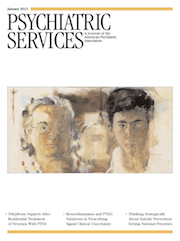Substance Screening and Referral for Substance Abuse Treatment in an Integrated Mental Health Care Program
Abstract
Objective
This study examined rates of substance screening and referral for substance abuse treatment as part of an integrated care program providing mental health services to low-income patients in primary care.
Methods
Adults (N=11,150) who were enrolled in the program between 2008 and 2010 were included. Primary outcomes included substance screening rates, treatment referral rates, and correlates of accessing recommended treatment.
Results
A total of 7,513 (67%) participants were screened for substance abuse. Among the 2,856 (38%) participants with a positive screen, 1,344 (47%) were referred for treatment. After adjustment for covariates, accessing recommended treatment was associated with past substance abuse treatment history, alcohol use, heavy drug use, posttraumatic stress disorder, and number of follow-up contacts with a care manager.
Conclusion
This study of a vulnerable population highlights missed opportunities for identifying and referring patients in primary care to substance abuse treatment.



